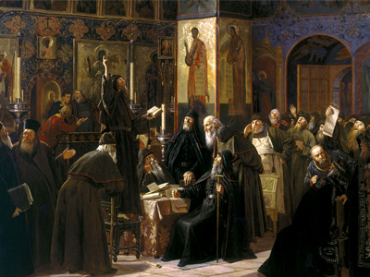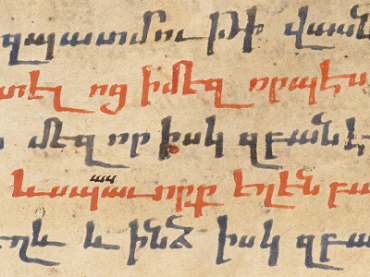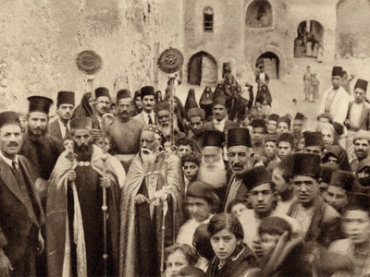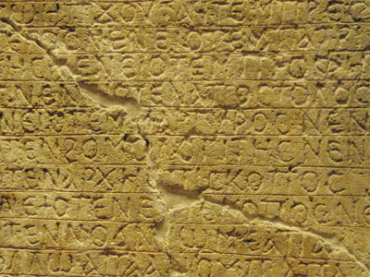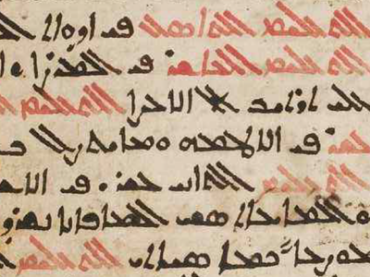Syriac and Eastern Christianity
1 Maccabees According to the Syriac Peshitta Version with English Translation
Series: Surath Kthob 13
ISBN: 978-1-4632-0585-0
This volume is part of a series of English translations of the Syriac Peshitta along with the Syriac text carried out by an international team of scholars.
$150.00 $120.00
The Gospel of Mark According to the Syriac Peshitta Version with English Translation
English Translation by Jeff W. Childers; Text Prepared by George Anton Kiraz
Series: Surath Kthob 28
ISBN: 978-1-61719-561-7
This volume is part of a series of English translations of the Syriac Peshiṭta along with the Syriac text carried out by an international team of scholars. Childers has translated the Peshiṭta of Mark, while Kiraz has prepared the Syriac text in the west Syriac script, fully vocalized and pointed. The translation and the Syriac text are presented on facing pages so that both can be studied together. All readers are catered for: those wanting to read the text in English, those wanting to improve their grasp of Syriac by reading the original language along with a translation, and those wanting to focus on a fully vocalized Syriac text.
$150.00
The Gospel of Luke According to the Syriac Peshitta Version with English Translation
English Translation by Jeff W. Childers; Text Prepared by George Anton Kiraz
Series: Surath Kthob 29
ISBN: 978-1-4632-0241-5
This volume is part of a series of English translations of the Syriac Peshiṭta along with the Syriac text carried out by an international team of scholars. Childers has translated the Peshiṭta of Luke, while Kiraz has prepared the Syriac text in the west Syriac script, fully vocalized and pointed. The translation and the Syriac text are presented on facing pages so that both can be studied together. All readers are catered for: those wanting to read the text in English, those wanting to improve their grasp of Syriac by reading the original language along with a translation, and those wanting to focus on a fully vocalized Syriac text.
$150.00
The Gospel of John According to the Syriac Peshitta Version with English Translation
Series: Surath Kthob 30
ISBN: 978-1-4632-0412-9
This volume is part of a series of English translations of the Syriac Peshiṭta along with the Syriac text carried out by an international team of scholars. Childers has translated the Peshiṭta of John, while Kiraz has prepared the Syriac text in the west Syriac script, fully vocalized and pointed. The translation and the Syriac text are presented on facing pages so that both can be studied together. All readers are catered for: those wanting to read the text in English, those wanting to improve their grasp of Syriac by reading the original language along with a translation, and those wanting to focus on a fully vocalized Syriac text.
$150.00
The Book of Acts According to the Syriac Peshitta Version with English Translation
English Translation by Robert A. Kitchen; Text Prepared by George Anton Kiraz
Series: Surath Kthob 31
ISBN: 978-1-61143-932-8
This volume is part of a series of English translations of the Syriac Peshitta along with the Syriac text carried out by an international team of scholars.
$150.00
Romans and Corinthians 1/2 According to the Syriac Peshitta Version with English Translation
English Translation by Daniel King; Text Prepared by George Anton Kiraz
Series: Surath Kthob 33
ISBN: 978-1-61143-963-2
This volume is part of a series of English translations of the Syriac Peshitta along with the Syriac text carried out by an international team of scholars.
$150.00
Galatians to Philemon According to the Syriac Peshitta Version with English Translation
English Translation by J. Edward Walters; Text Prepared by George Anton Kiraz
Series: Surath Kthob 34
ISBN: 978-1-61143-893-2
This volume is part of a series of English translations of the Syriac Peshitta along with the Syriac text carried out by an international team of scholars.
$150.00
Hebrews & General Epistles According to the Syriac Peshitta Version with English Translation
Series: Surath Kthob 32
ISBN: 978-1-4632-0556-0
This volume is part of a series of English translations of the Syriac Peshi?ta along with the Syriac text carried out by an international team of scholars.
$150.00
Revelation According to the Syriac Version with English Translation
English Translation by Jerome Alan Lund; Text Prepared by George Anton Kiraz
Series: Surath Kthob 35
ISBN: 978-1-4632-0413-6
This volume is part of a series of English translations of the Syriac Peshitta along with the Syriac text carried out by an international team of scholars. Although the book of Revelation is not part of the Peshitta, it was translated into Syriac at a later date and added to the Harqlean version.
$150.00
Syriac Orthography (A Grammar of the Syriac Language, Volume 1)
ISBN: 978-1-4632-0183-8
This volume, the first in a comprehensive grammar of the Syriac language, is a thematic presentation of orthography in the Syriac grammatical tradition, bringing the study of Syriac writing closer to modern linguistic accounts of writing systems.
$75.00
Job According to the Syriac Peshitta Version with English Translation
Series: Surath Kthob 16
ISBN: 978-1-4632-0554-6
This volume is part of a series of English translations of the Syriac Peshitta along with the Syriac text carried out by an international team of scholars. Loopstra has translated the text, while Kiraz has prepared the Syriac text in the west Syriac script, fully vocalized and pointed. The translation and the Syriac text are presented on facing pages so that both can be studied together. All readers are catered for: those wanting to read the text in English, those wanting to improve their grasp of Syriac by reading the original language along with a translation, and those wanting to focus on a fully vocalized Syriac text.
$150.00
Bardaisan of Edessa
Introduction by Jan Willem Drijvers; By H.J.W. Drijvers
Series: Gorgias Eastern Christian Studies 36
ISBN: 978-1-4632-0188-3
In this volume, a reprint of his 1966 monograph, H. J. W. Drijvers investigates the life and teachings of Bardaisan of Edessa, determining his place in the religious and cultural life of Edessa in the second half of the second century of the common era.
$163.00
The Martyrdom of St Phokas of Sinope
The Syriac Version
Introduction, translation and edition by Sebastian P. Brock
Series: Texts from Christian Late Antiquity 31
ISBN: 978-1-4632-0189-0
The fame of the martyr St. Phokas, first bishop of Sinope (on the Black Sea) and patron of seafarers, had spread to many parts of the Christian world by the fifth and sixth centuries. Although the Acts of his martyrdom under Trajan were composed in Greek, the earliest witness to them is the Syriac translation which is edited and translated here from two early manuscripts.
$34.00
The Nomocanonical Literature of the Copto-Arabic Church of Alexandria
Series: Coptic Studies Library 7
ISBN: 978-1-61719-188-6
Nomocanons (manuals of law) in Eastern Christianity give insights into the whole civil and religious life of communities, families and individuals. Nomocanonical literature is particularly abundant in the Coptic tradition, and the Rev. Franz Joseph Cöln describes five Nomocanons of the Coptic Church with a short account of their contents.
$136.00
Untersuchungen über die Geschichte des Königreichs Osroëne
Series: Syriac Studies Library 3
ISBN: 978-1-61719-417-7
This volume is a good quality reprint of the 1887 edition of Alfred von Gutschmid's classic text. It will be of interest to scholars in the Syriac-speaking kingdom of Osroene (or Edessa).
$141.00
Les Langues et les Littératures Araméennes
By J.-B. Chabot
Series: Syriac Studies Library 2
ISBN: 978-1-61143-011-0
Jean Baptiste Chabot, who produced works like Synodicon Orientale, surveys the different branches of the Aramaic Aramaic languages and their extant literature in theology, science, and history, as well as inscriptions at archaeological sites. Chabot demonstrates his expertise in the field, drawing from sources as diverse as the Samaritan Bible and the Talmud, Oriental Christianity, Babylon and Mesopotamia. Originally written in 1910, it will still be of interest to scholars in the fields of Aramaic, linguistics, Syriac studies and Eastern Christianity.
$141.00
The Account of the Syriac Orthodox Patriarch Yūḥanun Bar Šay Allāh (1483–1492)
The Syriac Manuscript of Cambridge: DD.3.8(1)
Series: Gorgias Eastern Christian Studies 34
ISBN: 978-1-4632-0213-2
This volume provides an analysis of a late fifteenth century document, a hitherto unpublished narration of the life and accomplishments of Yūḥanun Bar Šay Allāh, a fifteenth-century Syriac Orthodox Patriarch. It includes considerable unique historical information, shedding light on the history of the Syriac community in relation to other communities. It also supplies descriptions of events that brought important changes to the Syriac Church in Mesopotamia, Syria and Egypt.
$106.00
Commentary on Myron
Translation and Introduction by Fr. Baby Varghese
Series: Texts from Christian Late Antiquity 34
ISBN: 978-1-4632-0214-9
Moses bar Kepha: Commentary on Myron is an important witness to the history of the West Syriac Liturgy. Fr. Baby Varghese has translated the Syriac text into English for the first time.
$37.00
Concise Teachings of Christianity for Orthodox Families and Schools
By Gregorios Bulus Behnam; Translation and Introduction by Matti Moosa
ISBN: 978-1-4632-0215-6
Matti Moosa provides an introduction and a translation of Rev. Bulus Behnam’s 1946 work on the basic principles of the Christian faith based on the Holy Scriptures, showing that the Syrian Church considers the Holy Bible its sole authority for salvation.
$67.00
Journal of the Canadian Society for Syriac Studies 12
Edited by Amir Harrak
ISBN: 978-1-4632-0216-3
Volume 12 includes articles by Françoise Briquel Chatonnet, Kyle Smith, Adam Lehto, Mar Awa David Royel, Bernard Heyberger, Nasir al-Kaʿbi, Amir Harrak and Khalid Dinno.
$75.00
The Story of Mar Pinhas
Edited and Translated by Adam Carter McCollum
ISBN: 978-1-4632-0217-0
This volume contains the Syriac Life of Mar Pinhas, a purported martyr under the Sasanian Empire. This edition contains the Syriac text (first published in 1894 by Paul Bedjan), an English translation, explanatory annotations, and Addai Scher's Arabic version of the story.
$32.00
Hugoye - Journal of Syriac Studies (volume 15)
2012
General Editor George Anton Kiraz
Series: Hugoye: Journal of Syriac Studies 15
ISBN: 978-1-4632-0219-4
Widely regarded as a premier journal dedicated to the study of Syriac, Hugoye: Journal of Syriac Studies was established in 1998 as a venue devoted exclusively to the discipline. An organ of Beth Mardutho, the Syriac Institute, the journal appears semi-annually and will be printed in annual editions. A peer-reviewed journal, Hugoye is a respected academic source for up-to-date information about the state of Syriac studies and for discovering what is going on in the field. Contributors include some of the most respected names in the world of Syriac today.
$75.00
Lamen., Prayer & Ep of Jer, 1/2 Ep of Baruch According to the Syriac Peshitta with Eng. Tr.
English Translation by Donald M. Walter & Gillian Greenberg; Text Prepared by George Anton Kiraz & Joseph Bali
Series: Surath Kthob 23
ISBN: 978-1-4632-0230-9
This volume is part of a series of English translations of the Syriac Peshitta carried out by an international team of scholars. The fully vocalized and pointed Syriac text, and the English translation, are presented on facing pages so that both can be studied together. Supplementary information is given in annotations, Addenda, and Appendices.
$150.00
Patrologia Pacifica Tertia
Selected Papers Presented to the Asia-Pacific Early Christian Studies Society
ISBN: 978-1-61143-919-9
This volume collects selected papers from the seventh annual conference of the Asia-Pacific Early Christian Studies Society (APECSS), held in Seoul, Korea on 5–7th July 2012, on the theme "Preaching and Ministry in Early Christianity".
$199.00
Barhebraeus
A Bio-Bibliography
Series: Gorgias Eastern Christian Studies 9
ISBN: 978-1-59333-148-1
An extensive account of the life and works of Barhebraeus based on the latest research. It includes an appendix containing a comprehensive list of bibliographical references and manuscripts relating to Barhebraeus.
$231.00
Filter by
Filter by price
Filter by manufacturer


